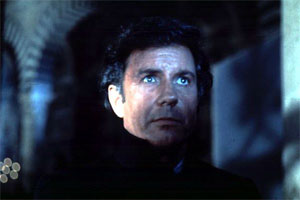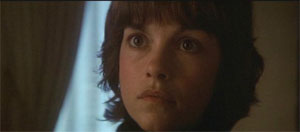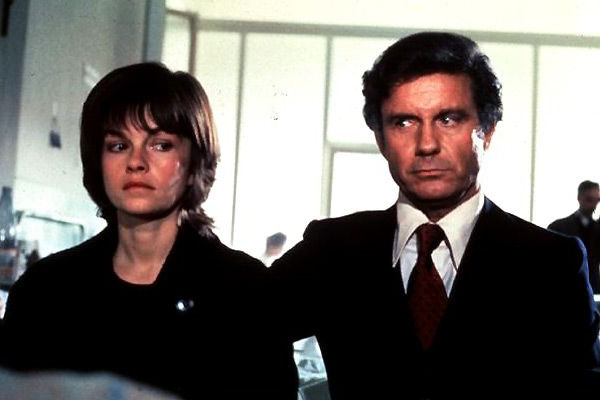Obsession (Dir. Brian DePalma, 1976):
Hitchcock’s Vertigo has been deconstructed from just about every angle of filmic and literary criticism over the years, and through it all it’s remained an enigmatic film. Not quite standard thriller, not quite supernatural mystery, not quite Douglas Sirk drama, the film still exerts a hypnotic push-pull with its clashing red-green color scheme, the unresolved crashing chords of Bernard Herrmann’s score, the uncommon sight of James Stewart rendered impotent and then psychotic by a ghost and a woman who never existed. For many, what lingers the most is the dual performance of Kim Novak as the woman Stewart lusts after and the ordinary shopgirl who plays the part. Soaring past any notion of reality to a realm of hyperreality, she represents the female in her tawdry and idealized states, unreachable and pliable, all seen through the eyes (lens?) of a man, and not just a man, but one of the most controlling and neurotic of directors.
Small wonder, with fertile ground like that, that Vertigo has been imitated and channeled many times since its release, from Lou Ye’s Suzhou River, which put a meta-modern spin on the storyline, to a Faith No More music video. Vertigo itself was out of circulation for nearly two decades until its re-release in 1984, and in the interim we had perhaps the most open cover version of them all, Brian DePalma’s Obsession.
As with Hitchcock’s film, any straight retelling of plot is almost beside the point, but to put it succinctly, Michael Courtland (Cliff Robertson) is a New Orleans real estate magnate whose wife (Genevieve Bujold) and daughter are kidnapped and then killed when a rescue operation by the police is botched. Fast forward seventeen years later, and on a business trip to Florence, Courtland chances upon Sandra (also Bujold), a local restoration artist who’s his wife’s spitting image, and their subsequent romantic entanglement leads to revelations of deceit, and murder.
 Obsession‘s reason for being is essentially spelled out when Sandra observes that a Renaissance painting she is restoring may have a brilliant classic image under the surface, but to get the image, one must deface the painting on top, which could be called a classic in its own right. And so it is with DePalma’s film, with screenwriter Paul Schrader playfully scrubbing away the surface of things to get to Vertigo‘s approach, if not its intent. As with Hitchcock, there are sudden outbreaks of violence that seem to come from some surreal nightmare, showy camerawork that nonetheless serves the narrative (most famous is a matched shot in which a 360-degree movement across the face of a tomb covers the span of seventeen years in a single minute), and a swooning, operatic love story.
Obsession‘s reason for being is essentially spelled out when Sandra observes that a Renaissance painting she is restoring may have a brilliant classic image under the surface, but to get the image, one must deface the painting on top, which could be called a classic in its own right. And so it is with DePalma’s film, with screenwriter Paul Schrader playfully scrubbing away the surface of things to get to Vertigo‘s approach, if not its intent. As with Hitchcock, there are sudden outbreaks of violence that seem to come from some surreal nightmare, showy camerawork that nonetheless serves the narrative (most famous is a matched shot in which a 360-degree movement across the face of a tomb covers the span of seventeen years in a single minute), and a swooning, operatic love story.
Does all this rise above being simply an artistic exercise, a tribute album? Just barely. The final revelation doesn’t stand up to much scrutiny, but it does give a perverse kick to Vertigo‘s scenario of false identities and deception. There’s also no denying the power of Obsession‘s first and final acts, in which two deadly traps are sprung on Courtland; in their gonzo intensity they’re as good as anything in DePalma’s work, and by the time Robertson is sprinting through an airport terminal in slow motion by the film’s climax, an automatic in one hand and a suitcase bursting open with cash in the other, one can’t help but get caught up in the voluptuousness of it all.
 Too bad that atmosphere and filmmaking brio are the film’s sole calling cards. Where Stewart supplied Vertigo with an emotional center, Robertson is mostly a blank zero, his character reduced to a plaything by the events of the film. Indeed, Obsession suffers the most when his character takes center stage, as it does in its draggy mid-section where he stalks Sandra and wins her heart. As Sandra, Bujold is an interesting choice as an object of desire — waif-like, perky, and self-aware, at first she seems all too knowing in comparison with the film’s stunned, angst-ridden tone (Vilmos Zsigmond’s cinematography recalls the widescreen joys of 50s melodramas), but as she sinks into madness she stirs herself into a fervor worthy of Kim Novak; all the emotional resonance of the film’s climax is due to her, and Bernard Herrmann’s potent score.
Too bad that atmosphere and filmmaking brio are the film’s sole calling cards. Where Stewart supplied Vertigo with an emotional center, Robertson is mostly a blank zero, his character reduced to a plaything by the events of the film. Indeed, Obsession suffers the most when his character takes center stage, as it does in its draggy mid-section where he stalks Sandra and wins her heart. As Sandra, Bujold is an interesting choice as an object of desire — waif-like, perky, and self-aware, at first she seems all too knowing in comparison with the film’s stunned, angst-ridden tone (Vilmos Zsigmond’s cinematography recalls the widescreen joys of 50s melodramas), but as she sinks into madness she stirs herself into a fervor worthy of Kim Novak; all the emotional resonance of the film’s climax is due to her, and Bernard Herrmann’s potent score.
Ah, Herrmann — returning to the scene of the crime, so to speak, his penultimate work is an orgy of sighing choirs, thundering organs, agitated strings, a valse lente both tragic and sweet. What lingers most from Obsession isn’t story or subtext — it’s the heavyweight battle between Herrmann’s music and DePalma’s style, and it’s not a fair fight. Somehow both dwarfing and amplifying the events on screen, Herrmann is lurid and beautiful, everything Obsession aspires to be.

